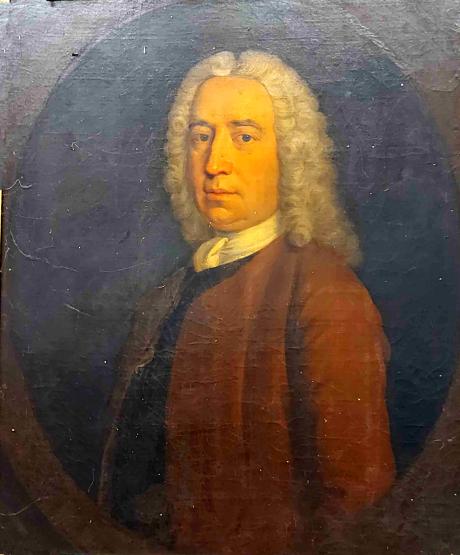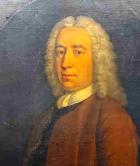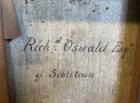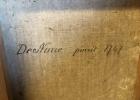inscribed signed and dated on the reverse " Richd Oswald Esq / of Scotstoun / De Nune Pinxit 1747"
By Direct family descent
In 1751, Alexander (1694–1766) and Richard Oswald (1687–1763), merchants in Glasgow and slave traders, bought Scotstoun, an estate of 1,000 acres. It included the lands of Balshagray to the west of Partick, stretching from the River Clyde to Great Western Road. The Scotstoun estate contained about 1,000 acres and stretched from the River Clyde to Great Western Road. It included not only the districts which we now know as Scotstoun and Whiteinch, but also Claythorn (Whittingehame Drive area) and lands around the former Knightswood Hospital. In fact by the late 1800’s the estate belonging to the Smiths of Jordanhill was almost surrounded by Oswald lands. In earlier times the Jordanhill Estate had included parts of Scotstoun and Gartnavel but they had been sold off to the Oswalds. Scotstoun Estate had, in the distant past, belonged to the house of Montgomerie but after 200 years they sold it in 1634 to John Hutchison, town clerk of Glasgow (no relation to the George Hutchison who founded Hutchison’s Hospital etc.) A couple of generations later the estate was sold in 1691 to William Walkinshaw, a Glasgow Merchant. William Walkinshaw’s eldest son John, who inherited the estate from his father, held Jacobite views and in 1715 he had to flee the country. As a result, under a recently passed Act, (for encouragement of loyal superiors, vassals, landlords and tenants in Scotland) the ninth Earl of Eglinton claimed and obtained the estate through a final decree from the Court of Session in 1719. In 1729 Lord Eglinton conveyed Scotstoun estate to his grandson Alexander the sixth Earl of Galloway. In 1750 the Earl sold the estate to William Crawfurd, a Glasgow merchant who was the eldest son of Matthew Crawfurd of Balshagray. There is a footnote in the old document to point out that these Crawfurds (with a “u”) of Scotstoun and Balshagray were not related to the Crawfords (with an “o”) of Jordanhill who were Crawfords of Kilbirnie. There is some confusion about this in Jordanhill since the Crawfurd Theatre at the College (Strathclyde University Campus) and Crawfurd House in Jordanhill School are both spelt with the “u”. See the history of the Smiths of Jordanhill at http://www.wsmclean.com/Smiths.htm
After the problems of the 1715 period had blown over, John Walkinshaw reappeared from exile and tried to reclaim his former estate, opposed obviously by Matthew Crawfurd. The matter was referred to arbitration and the estate was conveyed to Matthew’s son William Crawfurd. The Crawfurd family thus owned both Scotstoun and Balshagray estates.
In 1751 Scotstoun estate was sold to Richard and Alexander Oswald, two brothers and Glasgow merchants. In 1759 they acquired Balshagray. The Oswald Family History James Oswald was the son of a well-to-do Burgess of Kirkwall in Orkney, who came over to the mainland in the middle of the seventeenth century and settled in Wick. He had two sons, James and George who were both ministers. James was an Episcopal minister and George was a Presbyterian minister. James (the Episcopalian minister, 1654 –1699) had two sons Richard (1687 – 1766) and Alexander (1694 – 1763) who were rich merchants and shipowners. The brothers built themselves a grand mansion in the Stockwell area of Glasgow called “Oswald’s Land with great cellars below to store tobacco and wines but it was demolished around 1875 to make way for the new bridge being built for the Union Railway Company. They bought Scotstoun estate in 1751. They were bachelors and died at Scotstoun House (which had been built by the above mentioned William Walkinshaw). The estate passed to George Oswald, their second cousin (the son of the Presbyterian minister). See later. Meanwhile, George Oswald, (not the George mentioned in the lines above but the one referred to at the end of the paragraph earlier) who was the Presbyterian minister of Dunnet had eleven children, the eldest son being James. This James Oswald (1703-1793) was a minister like his father and succeeded him at the parish of Dunnet. He was a Doctor of Divinity and was the Moderator of the General Assembly in 1765. He later moved to Methven in Perthshire and stayed there as minister until he was aged over eighty when he moved to Scotstoun. He had a number of children, of whom his son George was to inherit Scotstoun Estate from the two bachelor brothers Richard and Alexander as explained earlier. We now come to “George Oswald of Scotstoun” (1735-1819) who inherited the estate in 1766. He was a successful Glasgow tobacco merchant and was also a partner in the famous Old Ship Bank. He was Rector of Glasgow University in 1797 His son James Oswald of Scotstoun (1774-1822) a captain in the Royal Navy inherited Scotstoun and when he died in 1822 (presumably unmarried) it passed to his sister Elizabeth (1767-1864). Just to complicate matters, there is another James Oswald (1779 – 1835) who was well known in Glasgow. This James was the elder son of Alexander Oswald of Shieldhall who was the brother of George Oswald of Scotstoun (see above). This James was MP for Glasgow and inherited the estate of Auchincruive. According to reference book called “St Mungo’s Bells” published in 1888, Oswald Street in Glasgow was named after the Alexander Oswald of Shieldhall.
Elizabeth was known as “Old Miss Oswald” and was born and died in Scotstoun House. By the age of 90 she had never seen a doctor and she died aged 98. On Elizabeth’s death, Scotstoun passed to the grandson of her sister Katherine. Katherine had married Robert Haldane of Airthrie so became Mrs Haldane. They had one married daughter, Mrs Haldane Gordon who had one son James Gordon Oswald. (Note how these families incorporated maiden names and inheritance names into their own name). James Gordon Oswald was the last owner of the estate of farmlands and it was he who started to feu off the estate for housing at the end of the 1800’s. He died at San Remo, Italy in 1897, but his obituary in the Glasgow Herald concentrated on the history of the family and said very little about the man himself. I have been unsuccessful in my research in the Mitchell Library to find any worthwhile references to him. However in the history of Scotstoun Churches there is a reference to the fact that he laid down a condition when granting fuels for Scotstoun which stated that “the trafficking or selling spiritous or fermented liquors is forever prohibited”. In 1885 the Partick Municipal Authorities negotiated with him to acquire the land for a public park which was subquently named Victoria Park to commemorate Queen Victoria’s Jubilee and it was opened in great style in July 1887 by Sir Andrew McLean , Provost of Partick. Following his death in 1897, he was succeeded by his son James William Gordon Oswald who cotinued to feu off the estate and his name appears in many title deeds for South Jordanhill. I have been unable so far to find any information on this latest Oswald, but in the book “The Claythorn Story” published by Claythorn Community Council in 1990, there is a report that in 1910 he built the Anniesland Mansions on the south side of Great Western Road and he died in 1938. Unlike the Smiths of Jordanhill whose family (and all its branches) was fully recorded in “Burke’s Landed Gentry”, there is no entry for the Oswalds of Scotstoun. There is however a full entry for the Oswalds of Auchincruive which relates to another branch of the Oswald family mentioned briefly above. JAMES OSWALD, son of a well-to-do Burgess of Kirkwall, about the middle of the seventeenth century crossed over to the mainland, and settled in Wick. There he became a Burgess and a Bailie, and owner of "Oswald's Land," an old tenement that his descendants own now. By his wife, Barbara Coghil, daughter of Coghil of that Ilk, he left two sons, James and George. They were both ministers, they married sisters, and they and their families after them were closely attached. But they differed widely in religion and in politics. In 1683, when the elder brother was ordained, the pious Charles, by help of the evangelists Lauderdale and Clavers, was seeking to convert Scotland to the religion of a gentleman, and so James Oswald was an Episcopal minister, and his family grew up keen Episcopalians and Jacobites.
In 1697, when the younger brother was ordained, Scotland had been left to settle in her own way her form of Church Government, and so George Oswald was a Presbyterian minister, and his family grew up staunch Presbyterians and Whigs. The Episcopalian branch died out in the first generation : the other still flourishes. I. JAMES OSWALD, minister of Watten in Caithness, born in 1654, died 1699, married Mary Murray, daughter of Richard Murray of Pennyland and Jean Smith of Methven, and had two sons and five daughters. All of these died without issue. Of the daughters - Margaret, who married Baird of Chester Hall, was one of the Jacobite ladies who, in the '45, were presented at the melancholy Court held in the Shawfield Mansion, and she never, it was alleged, recovered Prince Charlie's kiss. The two sons, RICHARD OSWALD, born 1687, and ALEXANDER OSWALD, born 1694, came to Glasgow early in last century, and became rich merchants and shipowners. Alexander Oswald is named among M'Ure's "sea adventurers." Of the forty-one "ships, brigantines, and sloops" that made-up the foreign fleet of Glasgow in 1735, the Oswalds owned three, the Martha, the Amity, and the Speedwell. They traded to Virginia, to the West Indies, and to Madeira. In 1742 they built themselves "Oswald's Land" in the Stockwell, (4) for their house and their counting-house, with great cellars below for the Tobacco and the Madeira. In 1751 they bought Scotstoun, and in 1759 Balshagray. They took a warm interest in the erection in 1750 of St. Andrew's "English Chappel," long known as the "Whistling Kirk," (5) and Alexander was its first praeses. They had been suspected in the '45 of helping the Prince's financial arrangements, and it was perhaps as a persona grata that Richard was chosen one of the six Commissioners to treat with the rebel requisitioner, Squire Hay (see Mount Vernon) : it is said to have been for his good services in this matter that the Oswalds had a grant of their burial place in the nave of the High Church. (6) The brothers were kindly, hospitable, and generous old bachelors, with a special warm side to any one from Caithness. They both died at Scotstoun, Alexander, on 24th January 1763, Richard, on 12th August 1766, when Scotstoun passed to George Oswald, eldest son of their double first cousin. This link between Glasgow, London and West Africa is well demonstrated by the Oswald family. Richard (1687–1763) and Alexander Oswald (1694–1766) came from Caithness and assumed a prominent position in Glasgow society based on the trade in tobacco, sugar and wine. They traded with Virginia, the West Indies and Madeira. They built ‘Oswald’s Land’ in Stockwell Street in 1742 and invested in landed estates around Glasgow at Scotstoun in 1751 and Balshagray in 1759. That they had links with the slave trade is beyond doubt. Richard Oswald was described as the foremost authority in Glasgow on the slave trade at Alexander Horsburgh’s trial in 1725. There are many reminders still to be seen in Glasgow’s streets of the Oswald’s standing in the ‘Merchant City’. Richard was commissioned to meet the Jacobite negotiator, Squire Hay, after Charles Stuart, the young Pretender, occupied Glasgow in 1745. The Oswalds were involved in the construction in 1750 of the church of St Andrew’s by the Green, also known as the ‘Whistling Kirk’. Alexander became its first patron. St Andrew’s, similar in style to Glasgow’s Palladian villas, is an enduring reminder of the status of the men who traded in human misery as well as tobacco and sugar.
Richard Oswald (1687-1766) was a prominent Glasgow merchant who was "involved in West Indies and Madeira trade as well as tobacco importation." In partnership with his brother Alexander, the firm owned three ships (the Martha, the Amity, and the Speedwell ) of the 41 sailing from Glasgow in 1735. ( Devine, T.M. The Tobacco Lords: A Study of the Tobacco Merchants of Glasgow and their Trading Activites c. 1740-90. [Edinburgh: John Donald Publishers Ltd]. p. 183; and "The Old Country Houses of the Old Glasgow Gentry: LXXXVII: Scotstoun." )
Another example of members of the merchant elite being directly connected to religion can be seen in a few surviving sermons of Reverend James Oswald, minister of Dunnett, who was brother to Richard and Alexander Oswald of Scotstoun (1687-1766 and 1694-1765 respectively). Richard and Alexander Oswald were major traders not only in tobacco but wine from France and Madeira from the island of the same name. They were mentioned by McUre as Virginia and Jamaica shipowners as early as 1735 with 3 ships' , and had their own company of merchants which included John Stevenston and James Dennistoun. 106 Their other business interests included Dennistoun, Buchanan and Co., Glasgow Bottleworks Co., Port Glasgow Ro p ework Co., Oswald and Co., and the United Sugar House Co. Apart from the estate of Scotstoun they also built Oswald's land in the Stockwell, now Oswald Street.1 (Source: https://theses.gla.ac.uk/4540/1/1990PetersPhD.pdf )
Devine's work is availble here to read online and may give more context:
|
|
|
|
|
There were around 500 merchants in a population of 12,000. It has been estimated that about 125 of them specialised in overseas trade. In practice, access to transatlantic trade was restricted to those who had the necessary financial means, colonial experience and the trading and kinship contacts. As a result, the colonial merchants were a small group from the wealthiest end of Glasgow society. They dominated the town council and influenced most aspects of Glasgow’s development. Their privileged status was reflected in their early headquarters, The Merchants Hospital. The geographical location of Glasgow made it ideally situated for the Atlantic colonial trade. It was at the head of the main trading artery, the River Clyde, a short distance from its satellite ports of Greenock and Port Glasgow. The rapid expansion of the tobacco trade with the Chesapeake, which straddled Maryland and Virginia, lay behind the improvement of Port Glasgow in the 1720s and the rebuilding of the harbour at the Broomielaw to accommodate larger sea-going vessels
After 1700 tobacco quickly established itself as the most important export from the American colonies. Glasgow soon became the main market-place. Imported tobacco was rapidly re-exported to England, France, Holland and Germany. This entrepôt trade resulted in a rapid accumulation of wealth, allowing huge fortunes to be made by a small number of Glasgow merchants. The scale of new wealth in Glasgow was unprecedented and it created a new breed of aristocracy. The ‘Virginia Dons’ dominated the public and private domain of the city for the next hundred years. The impact of the new-found wealth of merchant families such as the Bogles, Dunlops, Oswalds and Buchanans had a profound impact on the urban environment as the rapid influx of colonial wealth prompted conspicuous consumption.
Merchants displayed their new wealth and rise in social status by building large mansions, which created a new townscape in Glasgow. Those of lower social standing were crammed in tenements in the medieval heart of the town, while the colonial trading aristocracy built new, fashionable streets, often named after themselves or the colonies where their fortunes were made. The storage method used by Glasgow merchants was new, specifically designed for tobacco purchasing. Permanent stores were built across rural Virginia, Maryland and North Carolina which allowed factors to purchase tobacco direct from the planters. Each store was a self-sufficient enterprise run by factors who were usually young Scottish apprentices. Indentured servants were used as clerks and black slaves did the manual work. The tobacco was usually traded for manufactured goods exported across the Atlantic and advanced on credit to the planters.
Glasgow’s textile industry also to some extent expanded due to colonial investment. The West Indian supply of cotton ensured the wheels were spinning to produce linen, wool and silk for re-export. From 1750 until 1775, most of these exports went to America and the Caribbean. The slave islands became both the primary producer and the export market of a rough ‘slave cloth’ which became the basic attire of many transported Africans. The cotton was grown by slaves, shipped across the Atlantic by merchants such as Alexander Houston and Co., woven in Glasgow factories and then exported back – an extension of the city’s highly profitable role as an entrepôt.
The first banks in Glasgow – the Arms Bank (1750), the Ship Bank (1750) and the Thistle Bank (1761) were all directly funded by tobacco lords. The Ship Bank was situated in the then commercial centre of Glasgow, at the corner of the Briggait and the Saltmarket. The building which housed the Ship Bank had been built as early as 1640 by Provost Bell and was typical of the period with three storeys. That building is gone although the Old Ship Bank, a pub, stands in its place.
Oswald St in Glasgow still holds the same name and is a reminder of the legacy of Richard and Alexander.
William Denune was working as a portrait painter in Edinburgh from 1729,William Denune was an Edinburgh based portrait painter. The son of a Haddington surgeon, in 1729, aged only 14, he was the youngest member of the Academy of St Luke, Edinburgh’s first art school. Denune went on to build up a successful portrait practice in Edinburgh, Glasgow and Dumfries in the 1740s. He painted aristocrats like the Duke of Hamilton but also middle-class merchants, businessmen and their families. His work was certainly influenced by Allan Ramsay, but also by earlier Scottish painters like John Medina and William Aikman, who were known for their realism. Unfortunately Denune died before he could become better known, aged only 35 years. Denune's portraits have a solid, straightforward quality.




